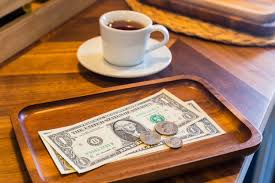Tipflation
 Lately, it feels as if we are prompted to tip everywhere we go. No longer is tipping
just a restaurant thing. So, the question is, when do we tip, and when can we say
no to tipping without feeling bad about that choice.
Lately, it feels as if we are prompted to tip everywhere we go. No longer is tipping
just a restaurant thing. So, the question is, when do we tip, and when can we say
no to tipping without feeling bad about that choice.
This blog post dives into the history of tipping, why tipping became so big in recent years, and ends with actionable things to keep in mind next time you are prompted to leave a tip.

The concept of tipping in America came with the end of slavery as a way for employers to hold laborers to a certain standard and make them work hard to earn their wages. According to Katie from podcast Money with Katie, this is the employer’s way of making workers “prove their worth.” That’s the point, Katie says. Fast forward to recent years, we have seen an enormous surge in options to tip post-pandemic. With the stock market drop, business owners are using tipping as a way to bring in extra income. This brings me to my next point. Who is our tip money actually going to?

First of all, just ask where your tip money is going? But, the short answer is, the employer has full control over that money if it’s on their electronic payment system. In other words, it may not be going to the kind cashier who checked you out. A recent NPR business article says that electronic tipping goes directly to the company, and it’s up to them and their policy in place for tips. Tipping is a way for employers to cut costs and not pay fair wages, says both NPR reporters and podcast host Katie. It shouldn’t be on us to make sure workers get paid fairly. That is the employer’s job.
Fair wage issue aside, here are some rules of thumb for tipping, according to Money
with Katie
and NPR Business:
- Takeout: tip 10-15%
- Delivery (e.g. Uber Eats): 20% tip for driver; 25% if bad weather
- If the bill total gets super high, it may make more sense to tip a dollar amount rather than a percentage for things like takeout and food delivery, where the service doesn’t go up as the price of the meal does.
- Dine in: the usual! Just do a percentage of the bill
- More of an experience, so tip larger as the quality and service go up, unlike for delivery.
Some things to keep in mind: there is nothing wrong with not tipping. Tip fatigue is a real thing, and it’s okay to prioritize your budget over tipping. Remember, it’s the employer’s job to make sure staff are getting paid fairly, not the consumer’s. Tipping a barista or a server is important, and we need to keep doing that, but tipping 30% for a pair of socks at a boutique store is not necessary. That said, tipping can be a great way to give back, says Ramit Sethi. You could have a goal to always tip 50% anytime you are prompted to tip. Just remember, you have to put on your own oxygen mask before saving someone else.
- https://www.npr.org/2022/12/27/1145579337/tipflation-why-youre-not-alone-if-youre-being-asked-to-tip-more-often
- https://podcast.moneywithkatie.com/how-much-should-we-really-be-tipping/
Categories
- Advice
- Budgeting
- Business
- Consumer
- Credit
- Credit Cards
- Credit Repair
- Credit Score
- Dating
- Expenses
- Fair Wages
- Finances
- Financial Preparation
- Financing
- Goals
- History
- Holidays
- Inflation
- Investing
- Love
- Money
- Pandemic
- Personal Finance
- Planning
- Ratios
- Savings
- Self Care
- Service Industry
- Spending
- Students
- Tipflation
- Tipping
- Travel
